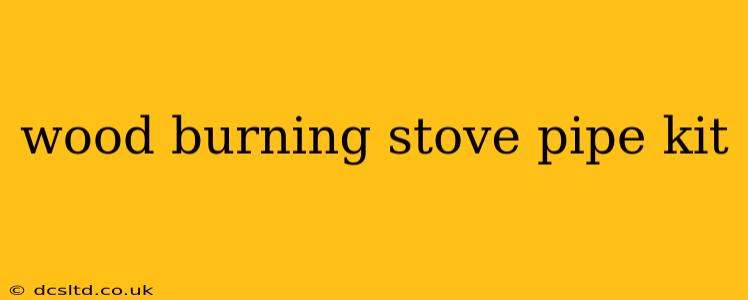Choosing the right wood burning stove pipe kit is crucial for both safety and efficiency. A poorly installed chimney system can lead to dangerous carbon monoxide buildup, creosote fires, and inefficient heating. This guide will help you navigate the world of stove pipe kits, ensuring you make an informed decision for your home.
What is a Wood Burning Stove Pipe Kit?
A wood burning stove pipe kit is a pre-packaged collection of components needed to safely vent the exhaust gases from a wood-burning stove through your home's structure and out to the exterior. These kits typically include:
- Pipe Sections: These are the lengths of pipe that connect together to form the chimney. They're usually made of stainless steel, double-walled for better insulation and safety.
- Elbows: Used to change the direction of the pipe, navigating around obstructions in your home.
- Thimbles: These are metal sleeves that protect the pipe where it passes through combustible materials like walls or ceilings.
- A Flashing Kit: This kit helps create a waterproof seal where the pipe exits the roof.
- A Chimney Cap: This protects the top of the chimney from rain, snow, and debris.
- Clamps or Connectors: Securely fasten the pipe sections together.
What Size Wood Burning Stove Pipe Kit Do I Need?
Determining the correct size is paramount for safe and efficient operation. The diameter of the pipe must match the outlet diameter of your wood-burning stove, as specified in your stove's manual. Never use a pipe that is too small, as this will restrict airflow and increase the risk of creosote buildup. Using a pipe that is too large can also be problematic, potentially leading to draft issues.
What Material Should My Wood Burning Stove Pipe Kit Be Made Of?
The most common material for wood burning stove pipe kits is stainless steel. Stainless steel is durable, resistant to corrosion, and can withstand high temperatures. While other materials exist, stainless steel offers the best combination of safety and longevity. Look for a kit with a high-quality stainless steel rating, often indicated by a grade number (e.g., 304 or 430).
What are the Different Types of Wood Burning Stove Pipe Kits?
Several types of kits cater to different needs and installations:
- Single-wall kits: Less expensive but require more insulation and are generally less safe. Not recommended for interior installations.
- Double-wall kits: Offer superior insulation, reducing the risk of fire hazards and heat loss. The preferred choice for most installations.
- Kits with insulated connectors: Some kits feature insulated connectors for added safety and efficiency in areas where the pipe passes through walls or ceilings.
How Do I Install a Wood Burning Stove Pipe Kit?
Installing a wood-burning stove pipe kit is a complex task requiring specific knowledge and adherence to local building codes and fire safety regulations. Improper installation can lead to serious hazards. It's strongly recommended to hire a qualified professional chimney installer for this work. Attempting DIY installation without the proper knowledge and tools can be dangerous and void any warranties.
Is it Safe to Install a Wood Burning Stove Pipe Kit Myself?
While some individuals attempt DIY installation, it's generally not recommended unless you have extensive experience and are completely familiar with local building codes and fire safety regulations. Incorrect installation can lead to dangerous situations, including house fires and carbon monoxide poisoning. Professional installation ensures compliance with safety standards and provides peace of mind.
What are the Common Mistakes When Installing a Wood Burning Stove Pipe Kit?
Several common errors can compromise safety and efficiency:
- Incorrect pipe sizing: Using the wrong diameter pipe can affect draft and create fire hazards.
- Poor sealing: Leaks in the system can allow dangerous gases to escape.
- Improper clearances: Maintaining sufficient distance from combustible materials is crucial to prevent fires.
- Ignoring local codes: Failure to comply with building codes can lead to legal issues and safety risks.
Maintaining Your Wood Burning Stove Pipe Kit
Regular maintenance is vital for extending the life of your pipe kit and ensuring safe operation. This includes:
- Annual inspections: A professional chimney sweep should inspect your chimney system annually to check for creosote buildup, damage, and any other issues.
- Creosote removal: Creosote is a highly flammable byproduct of wood combustion. Regular cleaning is essential to prevent chimney fires.
By carefully considering these factors and prioritizing professional installation and maintenance, you can ensure your wood-burning stove provides safe and efficient heat for many years to come. Remember, safety should always be your top priority when working with wood-burning stoves and their associated chimney systems.
